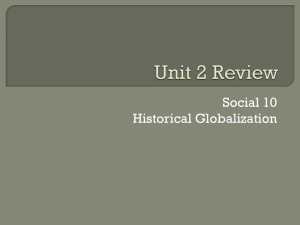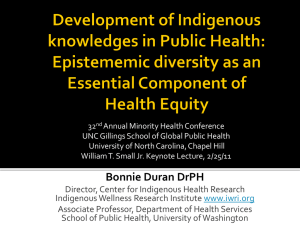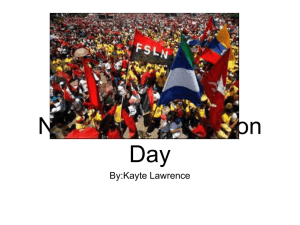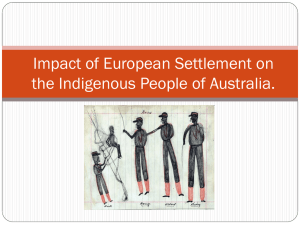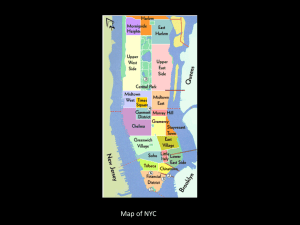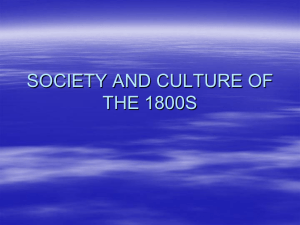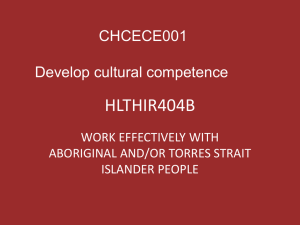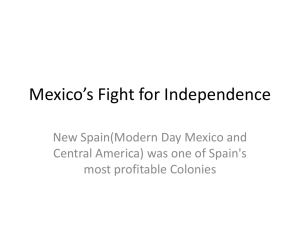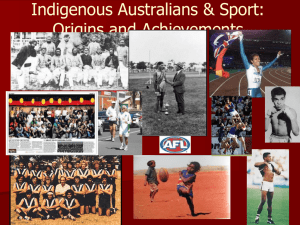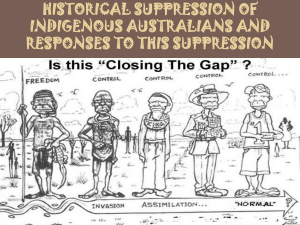bluefields black- creole indigenous government
advertisement
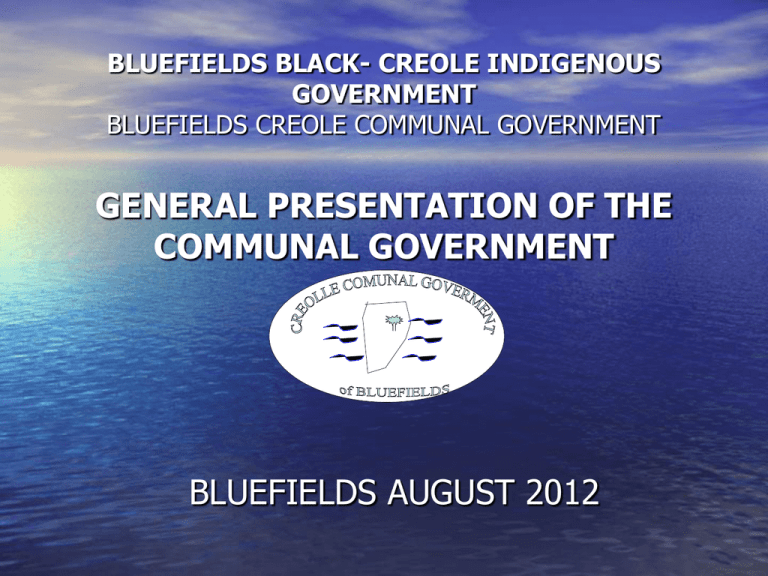
BLUEFIELDS BLACK- CREOLE INDIGENOUS GOVERNMENT BLUEFIELDS CREOLE COMMUNAL GOVERNMENT GENERAL PRESENTATION OF THE COMMUNAL GOVERNMENT BLUEFIELDS AUGUST 2012 PRESENTATION • In the past, on the Atlantic Coast of Nicaragua existed different forms of expressions of selfgovernment, addressed to conduct the development of communities, however these structures even having a legal and judicial base, were not supported by social, political and economical sectors of the region. Also the constant pressure of the government of Nicaragua and the lack of interest to comply with international and bilateral agreement did not permit the people of the Atlantic Coast to achieve a healthy life style. • Since the approval of the 28 Law (Autonomous Law, 1987) and the Law 445 (Territorial and Demarcation Law) in 2003 , the organization of the communal government and people became a moral and historical obligation for the indigenous and ethnical communities to conduct, develop and help direct a better life style for the people. • It is proven that a plan not based on the will of the community will not be a functional plan. For this, the Communal Assemble in coordination with the Directive Board have identified enough elements to construct and strengthen the Communal Government of the Black Creole Communities of Bluefields through different workshops organized for this purpose. • For the Black Creole community of Bluefields the responsibility to organize this task was established through the Directive Board, identifying the objectives of the Communal Government with the participation of all people that knows the history and reality of our community and who wants to participate in this process for the benefit of our future generation. LEGAL FUNDAMENTS FOR LAND CLAIM • • • • • • • • • • • • Mosquito Kingdom (1630-1843) English Protectorate (1843-1860) Managua Treaty (Incorporation of the Mosquito Coast (1860-1894) Arbitration of the Emperador of Austria (1881) Moskitia Convention (1894) Harrison-Altamirano Treaty (1905) Executive decree that gives rights to creole to get benefit to the land as indigenous (1933) Nicaragua Political Constitution (1985, 1997) Autonomy Law (1987) and its regulation in 2003 Demarcation Law (2003) UNITED NATIONS DECLARATION ON THE RIGHTS OF INDIGENOUS PEOPLES (2007) OIT (Convention No. 169) from 1989 and approved by Nicaragua Government in 2010 LEGAL FUNDAMENTS FOR LAND CLAIM • Evidences of the existence of the Moskitia: – Nicaragua Constitution 1834 • Nicaragua was constituted by the parties of Nicaragua, Masaya, Subtiava, Segovias, Matagalpa, Managua, León, Granada y Realejo. The Moskitia was not part of Nicaragua constitution. – Convention between the Commission of the Sovereign State of Nicaragua and the principal Moskito Coast Chief. • Agreed to give security to by passers through their territory. LEGAL FUNDAMENTS FOR LAND CLAIM – Managua Treaty, where it is recognize the sovereignty and territory through municipal constitution • This includes the acceptance of the Moskitia Sovereignty and the willfully integration to the State of Nicaragua • The Treaty between England and Nicaragua recognizes the Sovereignty of the Moskitia. – Clayton-Bulwer Treaty • United States and England compromise not to colonize and take over Nicaragua, Costa Rica, la Moskitia and any parts of Central America. LEGAL FUNDAMENTS FOR LAND CLAIM – (Austria’s Emperor Mediation Agreement) – Laudo Arbitral del Emperador de Austria • Recognizes sovereignty over natural resources concessions to the Government of the Moskitia • Free Trade • Rent to the State of the Moskitia • Rights to hoist their own flag – Reincorporation Decree • Military occupation of Bluefields (pretext of war with Honduras). • Arguments: separatism, independence • Violation of Uti possidetis juris principle • Elimination by force of the Miskito government LEGAL FUNDAMENTS FOR LAND CLAIM – Moskitia Conventión • Recognizes the free determination of the indigenous people to incorporate to Nicaragua • Recognizes the Moskitia as subjects to International Rights • Recognizes the self determination of indigenous people within the frame of special rights – Harrison-Altamirano Treaty • Evidence that the incorporation doesn't give rights of the property to the State of Nicaragua • Emphasizes the titling of the indigenous communities • Contradicts the International Rights LEGAL FUNDAMENTS FOR LAND CLAIM – Second Moskitia Convention • Recovery of sovereignty / pacta sunt servanda • Re-establishment of the Moskitia in equal political and judicial level with the State of Nicaragua. • Approval of Supreme Norms and Precepts of the Communal Moskitia Nation • Strategy to certify the territory – Acceptance of the Laudo Arbitral – Demand to the State of Nicaragua – Interpretation of the Moskitia Convention on to the National Assembly – Letter address to the president demanding respect to these rights – Demand to the Central American Court of Justice to interpret the Laudo arbitral. LEGAL FUNDAMENTS FOR LAND CLAIM – Legislative Decree that acknowledge property rights of the afro-descendants communities of Bluefields and recognizes them also as indigenous (1919). – Political Constitution of Nicaragua. • Articles (Artos): 5, 8, 11, 89, 90, 107, 121, 180, Recognize our rights as a people over our ethnic background, language, education, land, and resources. LEGAL FUNDAMENTS FOR LAND CLAIM Autonomy Law 28 Since 1894 we have struggled for our autonomy as we were living before. Its approval has served as: • Mechanism to end the war • Recognition of special rights to the indigenous and afrodescendant people • Creation of Regional Authorities • Self Government • Limitations: – – – – – – – – Doesn't recognizes historical rights and treaty Stealing the incomes from goods produced in the territory No control of the natural resources by the indigenous people No free trade No recognition to the rights to hoist historical flag No recognition of territorial jurisdiction (See Polanco Map) No recognition of traditional authorities (versus parties) No implementation of Special Funds for the development of the Atlantic Coast LEGAL FUNDAMENTS FOR LAND CLAIM DEMARCATION LAW 445 (considerations and articles): • It is the ineludible commitment of the State of Nicaragua to respond to the claim for the titling of the Lands and territories of the indigenous peoples and ethnic communities of the former Mosquitia of Nicaragua. • Arts. 3: Ethnic and Indigenous Territory: Is the geographic area covering the entire habitat of a group of indigenous or ethnic communities to integrate a territorial unit, where they develop in accordance with their customs and traditions. • Arts. 24: The State recognizes the rights of the indigenous and ethnic communities over the lands that they traditionally occupy. Likewise, it recognizes and guaranties the inalienability, inprescriptibility and the inability to embargo the land LEGAL FUNDAMENTS FOR LAND CLAIM • Arts. 29: The right of ownership over the communal land belongs collectively to the indigenous and ethnic communities. The members of the communities or group of communities have the rights of occupation and usufruct, according to the traditional forms of tenure of communal property. • Arts. 31: The Government of the Republic, the Autonomous Regions and the Municipalities shall respect the rights over the communal lands that they have traditionally occupied, as well as the rights over the natural resources, that the indigenous peoples and ethnic communities have traditionally exploited. LEGAL FUNDAMENTS FOR LAND CLAIM Adoption of the text of THE UNITED NATIONS DECLARATION ON THE RIGHTS OF INDIGENOUS PEOPLES Considerations: • That indigenous peoples have suffered from historic injustices as a result of their colonization and dispossession of their lands, territories and resources, thus preventing them from exercising, in particular, their right to development in accordance with their own needs and interests. • That treaties, agreements and other constructive arrangements, and the relationship they represent, are the basis for strengthened partnership between indigenous peoples and States. LEGAL FUNDAMENTS FOR LAND CLAIM • Arts. 26: Indigenous peoples have the right to the lands, territories and resources which they have traditionally owned, occupied, or otherwise used or acquired. States shall give legal recognition and protection to these lands, territories and resources. • Arts. 27: States shall established and implement, in conjunction with indigenous peoples concerned a fair, independent, impartial, open and transparent process giving due recognition to indigenous peoples laws, traditions, customs and land tenure systems, to recognize and adjudicate the rights of indigenous peoples pertaining to their lands, territories and resources. Indigenous peoples shall have the rights to participate in this process. • Arts. 28: Indigenous peoples have the rights to redress, by means that can include restitution or when this is not possible, just, fair and equitable compensation, for the lands, territories and resources which they have traditionally owned. HISTORICAL CLAIM • MOSQUITO COAST PEOPLE OF NICARAGUA – According to anthropologist the first inhabitants of the Mosquito Coast is dated from about 6000 years. – Other evidences are dated from 2500 and 1000 years back – Indigenous presence in Coco river, Prinzapolka (Prinzu Awala), Escondido, Matagalpa, San Juan del Sur, Punta Gorda and Corn Island – Miskitos, (Matagalpas), Ulwas, Sumu, Kukras, Ramas • PRESENCE OF BLACK PEOPLE ON THE MOSQUITO COAST – 1640 the mosquitos related about a shipwreck happen around Cape Gracias a Dios containing African slaves – Africans began to interrelate with the mosquito creating the Zambos-mosquitos (mixture of Miskito and black), they later became Miskitos. Bishop John Wilson – 1840 Creoles that were born from European and black that also came from Jamaica, Cayman Island and other Caribbean Island – 1860-1880 Garifunas originated from Saint Vincent Island and born from a mixture of African and Indian • RECOGNITION OF BLACK PEOPLE RIGHTS ON THE MOSQUITO COAST – Executive decree of the year 1933 that reforms the Law from the March 4, 1919 (Legislative Decree that gives property to the people of the former Mosquito Reserve actually called Zelaya Department), that stated that the word indigenous is also applied to the creoles Art. 1 COMPROMISE OF ACTUAL CENTRAL GOVERNMENT • AGREEMENT BETWEEN POLITICAL PARTIES (YATAMA-FSLN ) – Agreement No. 1 Continuation of Territorial Demarcation of indigenous and afro-descendants based on the Law No. 445 and the sentence of the CIDH about the Awas Tingni Case assuring the participation of the actors and beneficiaries to full conclusion, which means reactivating CONADETI and the CIDT, and titling the territories to the communities. – Agreement No. 2 Reform of the Autonomy Statute and its regulation in order to adjust its context according to historical rights of the people and their communities. – Agreement No. 3 Reform of the Electoral Law to include resolutions of the International Human Rights Court (CIDH) of the Organization of American States (OEA) that guarantee real participation and representation of indigenous and afrodescendant people. – Agreement No. 6 Detention of Agricultural Border to avoid the destruction of the forest and the reaping of natural resources of the Autonomous regions ORGANIZATION OF THE BLACK – CREOLE INDIGENOUS GOVERNMENT • CONSTITUTION OF NICARAGUA – Art. 8,11,49,89,90,91,121,180 181 establishes all rights for the Coast People and the recognition that Nicaragua is a multiethnic and pluricultural country with rights to organize freely in their traditional forms. • LAW 28 – Art. 11.4 Rights of the people ”to develop freely their social and productive organization according to their own values.” • LAW 445 – Art. 4. The communal Assembly constitutes the maximum authority of the indigenous and ethnic communities. – Art. 5. Communal Authorities are traditional government and administrative bodies representing the communities that elected them in accordance with their customs – Art. 6 Election, reelections, dismissals from office, and mandate periods of the communal and territorial authorities, shall be carried out according to the traditional procedures and customs of the indigenous communities and ethnic communities. ORGANIZATION OF CREOLE COMMUNAL GOVERNMENT OF BLUEFIELDS • 1914 CREOLES AND AFRODESCENDANT OF BLUEFIELDS PRESENTED A CLAIM TO • • • • • • • COLECTIVE RIGHTS TO THE LAND TO THE CHALKLEY TITILING COMMISION 1933 CREOLE COMMUNITY OF BLUEFIELDS GOT RIGHTS TO CLAIM AS INDIGENOUS PEOPLE 1935 HORATIO HODGSON MEMORIAL THAT CRY OUT FOR THE RIGHTS OF THE PEOPLE OF THE ATLANTIC COAST IN 1997 CREOLES ONCE MORE ORGANIZE TO CLAIM THE LAND BY DIFFERENT STUDIES DONE BY CARC (CENTRAL AMERICAN RESEARCH CENTER) INSTALATION OF FIRST CREOLE COMMUNAL GOVERNMET OF BLUEFIELDS – SEPTEMBER 2003 AT THE MORAVIAN GYM IN BLUEFIELDS NICARAGUA COMMUNAL ASSEMBLE TO RESTRUCTURE COMMUNAL GOVERNMENT OF BLUEFIELDS IN JUNE 2005 – MORAVIAN GYM COMMUNAL ASSEMBLE TO RATIFY CREOLE LAND CLAIM- 2006, 2007, 2008, 2009 COMMUNAL ASSEMBLE FOR ELECTION OF NEW COMMUNAL GOVERNMENT OF BLUEFIELDS –DECEMBER 2009 – FOR THE PERIOD 2010-2014 HIERARCHY STRUCTURE OF GOVERNMENTS IN NICARAGUA Political Constitution of the Republic of Nicaragua Executive Power National Assemble Regional Autonomous Councils Directive Board Municipal Government Coordinators of Regional Governments Communal Government HIERARCHY STRUCTURE OF THE COMMUNAL GOVERNMENT Communal Assemble Advisors Communal Judge Legal Representative Directive Board Enviormental an Nat. Resource Commission Social and Cultural Commission Communication Commission Electoral Commission Finantial Commission Infrastructure Commission Demarcation and Titling Commission Board of Elders • VISION: – The Black Creole Indigenous people of Bluefields is the rector of the development on the Atlantic Coast of Nicaragua, with a high sense of self-esteem, respect to all people, with responsibility, economical and political power, with a high civic value and administration, to conserve their natural and human resources in a sustainable manner for the welfare of the present and future generations. • MISSION: - To better the quality and the life of Black Creole Indigenous people of Bluefields to better the human development of its people, throughout demarcation of their land, the conservation of natural resources and motivating citizen participation for local development. GENERAL OBJECTIVE OF THE BLUEFIELDS BLACK – CREOLE INDIGENOUS GOVERNMENT • Principal Objectives: – Rescue the cultural, patrimonial, identity and customs through creation of awareness, to serve as instrument of development for the community through socio economical programs and projects identified by the necessity of the people and to consolidate the autonomic process. – Recover the communal territory of the Black Creole Indigenous community of Bluefields for sustainable development. SPECIFIC OBJECTIVES CONT.. • Rescue and promote the identity of the Black Creole Community of Bluefields through educational programs that promotes respect and welfare of the development of professional and to insert at all levels of education the obligatory subject of the Autonomy Law and Demarcation Law. • Recover the customs and traditions of the Black and Creole community of Bluefields in order to preserve our real identity and maintain respect before national and international public opinion • Recover the patrimony of the Black Creole Indigenous people of Bluefields to convert it in a source of employment. • Integrate all the people of the Black and Creole Ethnic community in and out of the country in order to create the unity of all people. SPECIFIC OBJECTIVES CONT.. • Foment the interrelation with other ethnic people and indigenous communities abroad and to other regions in the country. • Consolidate formal relationship with communal, municipal, regional, national and international authorities for the welfare of the Black Creole Indigenous Communal Government of Bluefields. • Organization of commissions to spare lead programs and projects that will serve to develop the productive potential in the territories that belongs to the Black Creole Community of Bluefields PRINCIPAL ACHIEVEMENTS • • • • • • • • • • • • • • • • • • • • • • • • • Political recognition of the Black Creole Indigenous government at all levels (municipal, regional, national international) Organization of Neighbourhood DB, Commissions, Board of elders Participation in public matters Election of representative to CONADETI/CIDT Establishment of office with equipment Elaborated the By laws of the Communal Government Electoral procedures elaborated Organization of Corn Island Communal Government Territorial Claim presented (2005) and admitted (2010) by the CIDT Organization of ordinary and extraordinary assembles Election of Communal representatives to the General Assemble Black Creole CENSUS Meeting with World Bank and MTI concerning the Highway Lobbying for the 25% established by Law 445 to the Communal Government Meeting with the National Assemble Commission concerning the proposed Coastal Law. Meeting with the all communal and territorial governments Meeting with the Rama and Spanish speaking population at the south of Bluefields Meeting with BICU Indigenous and Creole Students Coordination with the Black Creole of the RAAN Organization a technical team towards the process of demarcation and titling Support of advisors towards the Communal Government Meeting with the General Ombudsman (Procurador General de Derechos Humanos) Meetings with various national and international consultants around rights to land claim Presentation of claim to various municipalities and Municipal Council in the SAAR Defense of the regional territory in Rama Municipality CHALLENGES • Demarcation and Titling of the communal land claimed by the Communal Government and ratified by the assemble. • Promote a guide of good living and respect among all people living on the creole territory of Bluefields (guia de convivencia) • Rescue the cultural, patrimonial, tradition, customs and identity creating awareness in order to develop the community • Increase the participation of Black Creole people in the strengthening of the communal structures, commissions and government • Elaborate a plan for integral development (social, economical, productive and political) for Black creole indigenous people for Bluefields • Strengthen autonomical process Bluefieldsrights.wordpress.com • Contact us: bluecreolegov@gmail.com • THANK YOU!
